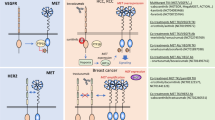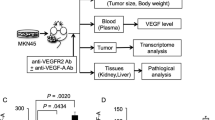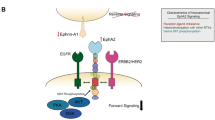Abstract
Cellular heterogeneity, redundancy of molecular pathways and effects of the microenvironment contribute to the survival, motility and metastasis of cells in solid tumors. It is unlikely that tumors are entirely dependent on only one abnormally activated signaling pathway; consequently, treatment with an agent that interferes with a single target may be insufficient. Combined blockade of functionally linked and relevant multiple targets has become an attractive therapeutic strategy. The EGFR and ERBB2 (HER2) pathways and VEGF-dependent angiogenesis have a pivotal role in cancer pathogenesis and progression. Robust experimental evidence has shown that these pathways are functionally linked and has demonstrated a suggested role for VEGF in the acquired resistance to anti-ERBB drugs when these receptors are pharmacologically blocked. Combined inhibition of ERBB and VEGF signaling interferes with a molecular feedback loop responsible for acquired resistance to anti-ERBB agents and promotes apoptosis while ablating tumor-induced angiogenesis. To this aim, either two agents highly selective against VEGF and ERBB respectively, or, alternatively, a single multitargeted agent, can be used. Preclinical studies have proven the efficacy of both these approaches and early clinical studies have provided encouraging results. This Review discusses the experimental rationale for, preclinical studies of and clinical trials on combined blockade of ERBB and VEGF signaling.
Key Points
-
The heterogeneity of tumors and the wide degree of crosstalk among different signaling pathways compel a therapeutic approach directed against multiple complementary targets
-
EGFR, ERBB2 and VEGF have close functional interactions, control tumor and endothelial cell compartments, and are involved directly in the mechanisms of resistance to current therapies
-
Combined targeting of ERBB receptors and VEGF-dependent signaling has proven to be a successful strategy in preclinical studies and has been translated to the clinical setting
-
There are two main strategies pursued in preclinical and clinical studies—the first is based on the combination of two selective agents, including monoclonal antibodies and small-molecule tyrosine kinase inhibitors that target ERBB and VEGF, and the second on single multitargeted small-molecule inhibitors that simultaneously block VEGF receptors and ERBB
-
Both approaches have been used in early clinical studies in different types of cancer, and activity has been obtained in different tumors, especially in non-small-cell lung cancer
-
The safety profile of multitargeted agents is generally good, and adverse effects seem to occur by the addition of chemotherapeutic regimens
This is a preview of subscription content, access via your institution
Access options
Subscribe to this journal
Receive 12 print issues and online access
$209.00 per year
only $17.42 per issue
Buy this article
- Purchase on Springer Link
- Instant access to full article PDF
Prices may be subject to local taxes which are calculated during checkout
Similar content being viewed by others
References
Citri A and Yarden Y (2006) EGF-ERBB signalling: towards the systems level. Nat Rev Mol Cell Biol 7: 505–516
Hynes NE and Lane HA (2005) ERBB receptors and cancer: the complexity of targeted inhibitors. Nat Rev Cancer 5: 341–354
Mendelsohn J and Baselga J (2006) Epidermal growth factor receptor targeting in cancer. Semin Oncol 33: 369–385
Normanno N et al. (2003) Target-based agents against ErbB receptors and their ligands: a novel approach to cancer treatment. Endocr Relat Cancer 10: 1–21
Baselga J and Arteaga CL (2005) Critical update and emerging trends in epidermal growth factor receptor targeting in cancer. J Clin Oncol 23: 2445–2459
Hanahan D and Folkman J (1996) Patterns and emerging mechanisms of the angiogenic switch during tumorigenesis. Cell 86: 353–364
Folkman J (1971) Tumor angiogenesis: therapeutic implications. N Engl J Med 285: 1182–1186
Ferrara N et al. (2003) The biology of VEGF and its receptors. Nat Med 9: 669–676
Fox SB et al. (2001) Angiogenesis: pathological, prognostic, and growth factor pathways and their link to trial design and anticancer drugs. Lancet Oncol 2: 278–289
Kerbel R and Folkman J (2002) Clinical translation of angiogenesis inhibitors. Nat Rev Cancer 2: 727–739
Patiar S and Harris AL (2006) Role of hypoxia-inducible factor-1alpha as a cancer therapy target. Endocr Relat Cancer 13 (Suppl 1): S61–S75
Shibuya M (2006) Differential roles of vascular endothelial growth factor receptor-1 and receptor-2 in angiogenesis. J Biochem Mol Biol 39: 469–478
Ellis L (2004) Epidermal growth factor receptor in tumor angiogenesis. Hematol Oncol Clin North Am 18: 1007–1021
Fan F et al. (2005) Expression and function of vascular endothelial growth factor receptor-1 on human colorectal cancer cells. Oncogene 24: 2647–2653
Gasparini G and Harris AL (1995) Clinical implication of the determination of tumor angiogenesis in breast carcinoma: much more than a new prognostic tool. J Clin Oncol 13: 765–782
Fontanini G et al. (1997) Vascular endothelial growth factor is associated with neovascularization and influences progression of non-small cell lung carcinoma. Clin Cancer Res 3: 861–865
Gasparini G et al. (2005) Angiogenic inhibitors: a new therapeutic strategy in oncology. Nat Clin Pract Oncol 2: 562–577
Gasparini G et al. (2005) Combination of angiogenic therapy with other anticancer therapies: results, challenges and open questions. J Clin Oncol 20: 1275–1311
Kim SJ et al. (2003) Blockade of epidermal growth factor receptor signaling in tumor cells and tumor-associated endothelial cells for therapy of androgen-independent human prostate cancer growing in the bone of nude mice. Clin Cancer Res 9: 1200–1210
Okamura et al. (1992) A model system for tumour angiogenesis: involvement of transforming growth factor-a in tube formation of human microvascular endothelial cells induced by esophageal cancer cells. Biochem Biophys Res Commun 186: 1471–1479
Hirata A et al. (2002) ZD1839 (Iressa) induces antiangiogenic effects through inhibition of epidermal growth factor receptor tyrosine kinase. Cancer Res 62: 2554–2560
Goldman CK et al. (1993) Epidermal growth factor stimulates vascular endothelial growth factor production by human malignant glioma cells: a model of glioblastoma multiforme pathophysiology. Mol Biol Cell 4: 121–133
Parikh AA et al. (2003) Expression and regulation of the novel vascular endothelial growth factor receptor neuropilin-1 by epidermal growth factor in human pancreatic carcinoma. Cancer 98: 720–729
Turini ME and DuBois RN (2002) Cyclooxygenase-2: a therapeutic target. Annu Rev Med 53: 35–57
Caputo R et al. (2003) Helicobacter pylori VacA toxin up-regulates vascular endothelial growth factor expression in MKN 28 gastric cells through an epidermal growth factor receptor-, cyclooxygenase-2-dependent mechanism. Clin Cancer Res 9: 2015–2021
Loureiro RM (2005) ErbB2 overexpression in mammary cells upregulates VEGF through the core promoter. Biochem Biophys Res Comm 326: 455–465
Wen XF et al. (2006) HER2 signaling modulates the equilibrium between pro- and antiangiogenic factors via distinct pathways: implications for HER2-targeted antibody therapy. Oncogene 25: 6986–6996
Phillips RJ et al. (2005) Epidermal growth factor and hypoxia-induced expression of CXC chemokine receptor 4 on non-small cell lung cancer cells is regulated by the phosphatidylinositol 3-kinase/PTEN/AKT/ mammalian target of rapamycin signaling pathway and activation of hypoxia inducible factor-1α. J Biol Chem 280: 22473–22481
Laughner E et al. (2001) HER2 (neu) signaling increases the rate of hypoxia-inducible factor 1α (HIF-1α) synthesis: novel mechanism for HIF-1-mediated vascular endothelial growth factor expression. Mol Cell Biol 21: 3995–4004
Izumi Y et al. (2002) Tumour biology: herceptin acts as an anti-angiogenic cocktail. Nature 416: 279–280
Tabernero J (2007) The role of VEGF and EGFR inhibition: implications for combining anti–VEGF and anti–EGFR agents. Mol Cancer Res 5: 203–220
Petit AM et al. (1997) Neutralizing antibodies against epidermal growth factor and ErbB-2/neu receptor tyrosine kinases down-regulate vascular endothelial growth factor production by tumour cells in vitro and in vivo: angiogenic implications for signal transduction therapy of solid tumours. Am J Pathol 151: 1523–1530
Bruns CJ et al. (2000) Epidermal growth factor receptor blockade with C225 plus gemcitabine results in regression of human pancreatic carcinoma growing orthotopically in nude mice by antiangiogenic mechanisms. Clin Cancer Res 6: 1936–1948
Ciardiello F et al. (2001) Inhibition of growth factor production and angiogenesis in human cancer cells by ZD1839 (Iressa), a selective epidermal growth factor receptor tyrosine kinase inhibitor. Clin Cancer Res 7: 1459–1465
Bruns CJ et al. (2000) Blockade of the epidermal growth factor receptor signaling by a novel tyrosine kinase inhibitor leads to apoptosis of endothelial cells and therapy of human pancreatic carcinoma. Cancer Res 60: 2926–2935
Perrotte P et al. (1999) Anti-epidermal growth factor receptor antibody C225 inhibits angiogenesis in human transitional cell carcinoma growing orthotopically in nude mice. Clin Cancer Res 5: 257–265
Kedar D et al. (2002) Blockade of the epidermal growth factor receptor signaling inhibits angiogenesis leading to regression of human renal cell carcinoma growing orthotopically in nude mice. Clin Cancer Res 8: 592–600
Viloria-Petit A et al. (2001) Acquired resistance to the antitumor effect of epidermal growth factor receptor–blocking antibodies in vivo: a role for altered tumor angiogenesis. Cancer Res 61: 5090–5101
Ciardiello F et al. (2004) Antitumor activity of ZD6474, a vascular endothelial growth factor receptor tyrosine inhibitor, in human cancer cells with acquired resistance to anti-epidermal growth factor therapy. Clin Cancer Res 10: 784–793
Vallbohmer D et al. (2005) Molecular determinants of cetuximab efficacy. J Clin Oncol 23: 3536–3544
Ciardiello F et al. (1996) Antitumor activity of combined blockade of epidermal growth factor receptor and protein kinase A. J Natl Cancer Inst 88: 1770–1776
Ciardiello F et al. (2000) Antiangiogenic and antitumor activity of anti-epidermal growth factor receptor C225 monoclonal antibody in combination with vascular endothelial growth factor antisense oligonucleotide in human GEO colon cancer cells. Clin Cancer Res 6: 3739–3747
Shaheen RM et al. (2001) Inhibited growth of colon cancer carcinomatosis by antibodies to vascular endothelial and epidermal growth factor receptors. Br J Cancer 85: 584–589
Jung YD et al. (2002) Effects of combination anti-vascular endothelial growth factor receptor and anti-epidermal growth factor receptor therapies on the growth of gastric cancer in a nude mouse model. Eur J Cancer 38: 1133–1140
Ryan AJ and Wedge SR (2005) ZD6474 a novel inhibitor of VEGFR and EGFR tyrosine kinase activity. Br J Cancer 92 (Suppl 1): S6–S13
McCarty MF et al. (2004) ZD6474, a vascular endothelial growth factor receptor tyrosine kinase inhibitor with additional activity against epidermal growth factor receptor tyrosine kinase, inhibits orthotopic growth and angiogenesis of gastric cancer. Mol Cancer Ther 3: 1041–1048
Drevs J et al. (2004) The VEGF receptor tyrosine kinase inhibitor, ZD6474, inhibits angiogenesis and affects microvascular architecture within an orthotopically implanted renal cell carcinoma. Angiogenesis 7: 347–354
Yokoi K et al. (2005) Dual inhibition of epidermal growth factor receptor and vascular endothelial growth factor receptor phosphorylation by AEE788 reduces growth and metastasis of human colon carcinoma in an orthotopic nude mouse model. Cancer Res 65: 3716–3725
Park YW et al. (2005) AEE788, a dual tyrosine kinase receptor inhibitor, induces endothelial cell apoptosis in human cutaneous squamous cell carcinoma xenografts in nude mice. Clin Cancer Res 11: 1963–1973
Dickler M et al. (2004) Phase II trial of erlotinib (OSI-774), an epidermal growth factor receptor (EGFR)-tyrosine kinase inhibitor, and bevacizumab, a recombinant humanized monoclonal antibody to vascular endothelial growth factor (VEGF), in patients (pts) with metastatic breast cancer (MBC). J Clin Oncol 22 (Suppl): 127s
Pegram M . et al. (2006) Phase II combined biological therapy targeting the HER2 proto-oncogene and the vascular endothelial growth factor using trastuzumab (T) and bevacizumab (B) as first line treatment of HER2-amplified breast cancer [abstract #301]. Presented at the 29th Annual San Antonio Breast Cancer Symposium December 14–17 2006, San Antonio, TX, USA.
Sarmiento R et al. (2007) Preliminary results of a dose-finding study of PTK787/ZK222584 (PTK/ZK) in combination with weekly vinorelbine (V) and trastuzumab (T) as treatment of patients (pts) with metastatic breast cancer (MBC) overexpressing HER-2/neu, previously treated with at least one line of chemotherapy (CT) [abstract #40247]. Presented at the American Society of Clinical Oncology Breast Cancer Symposium
Saltz LB et al. (2007) Randomized phase II trial of cetuximab, bevacizumab, and irinotecan compared with cetuximab and bevacizumab alone in irinotecan–refractory colorectal cancer: the BOND-2 study. J Clin Oncol 25: 4557–4561
Zhu Z (2007) Targeted cancer therapies based on antibodies directed against epidermal growth factor receptor: status and perspectives. Acta Pharmacol Sin 28: 1476–1493
Meyerhardt JA et al. (2007) Phase II study of FOLFOX, bevacizumab and erlotinib as first-line therapy for patients with metastatic colorectal cancer. Ann Oncol 18: 1185–1189
Herbst RS et al. (2005) Phase I/II trial evaluating the anti-vascular endothelial growth factor monoclonal antibody bevacizumab in combination with the HER-1/epidermal growth factor receptor tyrosine kinase inhibitor erlotinib for patients with recurrent non-small-cell lung cancer. J Clin Oncol 23: 2544–2555
Herbst RS et al. (2007) Phase II study of efficacy and safety of bevacizumab in combination with chemotherapy or erlotinib compared with chemotherapy alone for treatment of recurrent or refractory non small-cell lung cancer. J Clin Oncol 25: 4743–4750
Natale RB et al. (2006) ZD6474 versus gefitinib in patients with advanced NSCLC: final results from a two-part, double-blind, randomized phase II trial. J Clin Oncol 24 (Suppl): 364s
Heymach JV et al. (2004) ZD6474, a novel antiangiogenic agent, in combination with docetaxel in patients with NSCLC: results of the run-in phase of a two-part, randomised phase II study. J Clin Oncol 22 (Suppl): 207s
Heymach JV et al. (2007) Randomized, placebo-controlled phase II study of vandetanib plus docetaxel in previously treated non small-cell lung cancer. J Clin Oncol 25: 4270–4277
Hainsworth JD et al. (2005) Treatment of metastatic renal cell carcinoma with a combination of bevacizumab and erlotinib. J Clin Oncol 23: 7889–7896
Bukowski RM et al. (2007) Randomized phase II study of erlotinib combined with bevacizumab compared with bevacizumab alone in metastatic renal cell cancer. J Clin Oncol 25: 4536–4541
Mauer AM et al. (2004) Phase I study of epidermal growth factor receptor (EGFR) inhibitor, erlotinib, and vascular endothelial growth factor monoclonal antibody, bevacizumab, in recurrent and/or metastatic squamous cell carcinoma of the head and neck (SCCHN). J Clin Oncol 22 (Suppl): 497s
Vokes EE et al. (2006) A phase I study of erlotinib and bevacizumab for recurrent or metastatic squamous cell carcinoma of the head and neck (HNC). J Clin Oncol 23 (Suppl): 501s
Hainsworth JD et al. (2007) Phase II trial of bevacizumab and erlotinib in carcinomas of unknown primary site: the Minnie Pearl Cancer Research Network. J Clin Oncol 25 (Suppl): S1747–S1754
Preston et al. (2006) Multitargeted inhibition of the epidermal growth factor receptor (EGFR) and vascular endothelial growth factor receptor (VEGFR) pathways. A phase I study of cetuximab (C), erlotinib (E) and bevacizumab in carcinomas with solid tumors [abstract #3005]. J Clin Oncol 24
Bendell JC et al. (2007) Results of a phase I study of bevacizumab (BV), everolimus (EV), and erlotinib (E) in patients with advanced solid tumor [abstract #3548]. J Clin Oncol 25
Author information
Authors and Affiliations
Corresponding author
Ethics declarations
Competing interests
The authors declare no competing financial interests.
Rights and permissions
About this article
Cite this article
Tortora, G., Ciardiello, F. & Gasparini, G. Combined targeting of EGFR-dependent and VEGF-dependent pathways: rationale, preclinical studies and clinical applications. Nat Rev Clin Oncol 5, 521–530 (2008). https://doi.org/10.1038/ncponc1161
Received:
Accepted:
Published:
Issue Date:
DOI: https://doi.org/10.1038/ncponc1161
This article is cited by
-
An ultra-small bispecific protein augments tumor penetration and treatment for pancreatic cancer
European Journal of Nuclear Medicine and Molecular Imaging (2023)
-
Drug combination screening as a translational approach toward an improved drug therapy for chordoma
Cellular Oncology (2021)
-
Dual EGFR blockade with cetuximab and erlotinib combined with anti-VEGF antibody bevacizumab in advanced solid tumors: a phase 1 dose escalation triplet combination trial
Experimental Hematology & Oncology (2020)
-
Immune Checkpoint Blockade in Oncogene-Driven Non-Small-Cell Lung Cancer
Drugs (2020)
-
Combined application of anti-VEGF and anti-EGFR attenuates the growth and angiogenesis of colorectal cancer mainly through suppressing AKT and ERK signaling in mice model
BMC Cancer (2016)



